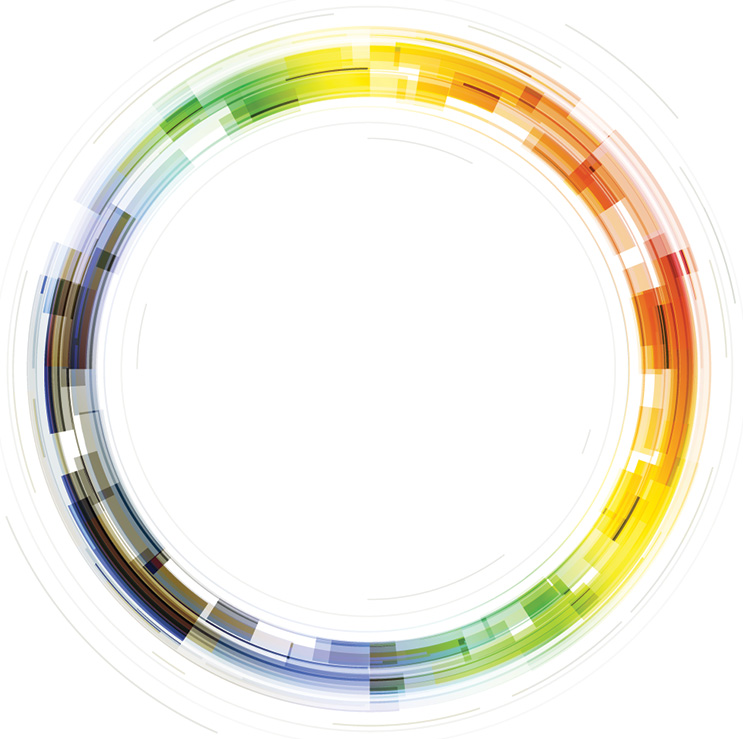(This reprinted from a post I wrote for my blog on Beehive Productions to augment a course we were offering)

We’re going into the last week of The Circle Way Deep Dive with Tenneson Woolf now, and it’s been a fabulous ride. Last week our focus was on subtleties, and the group was all over it. Part of our conversation centered (ha!) on how to host circle online, or in other environments where you can’t actually SEE the circle.
Time restraints made it challenging to really go into anything but the most immediate ideas then, so I’m bringing the overflow of my response here where we can keep talking if there is interest.
First, looking at circle as a shape – a round or circular form with a center and a circumference – reveals some interesting patterns that map across spatial limitations.
The Circle
The circle is probably the oldest form known to humans – it’s been with us since before the beginning of recorded history. It occurs naturally in the shape of the moon and the sun, and in the circular movement of the sun around the earth and seasons, the arc of the lunar cycle from month to month.
From the micro level of atoms and molecules, to the macro level of planets and their orbits, circles and spheres are found in every aspect of our experience. It’s the shape of the Medicine Wheel for Native Americans, and circles of protection for the ancient Celts, a universal symbol representing wholeness, completion, unity.
Every point of the circumference is at an equal distance to the center. So, in groups of people, the circle is symbolic of equality, where no person is more prominent than any other person.
The Center (or Centre when we’re wearing our British skins)

Buddhists use the wheel or circle as a way to talk about life, and Buddha taught that identifying one’s self with any point on the wheel was to become entangled in suffering, but the centre is the place of liberation, of observation without observer. The Centre remains still while everything else turns around it.
Another way to look at the Center is as the place of “witness”, of neutral observance, simple awareness. It’s the part of us that is aware of everything — just noticing, just being present, here now – witnessing as a state of complete acceptance, without personal bias or need to alter anything or judge it.
So speaking to the center, or listening from the center is a way to access that place of witness, of neutral observance. It gives us a kind of liberation from ourselves as individuals, and a doorway into a collective experience that is both non-personal and deeply human.
Circle Online
Or, as Tenneson says, BUST THE MYTH THAT IT CAN’T BE DONE. 🙂

So … Circle is a form, a pattern that manifests externally as circumference & a center,in this case the circumference being the people and the center being a focus of attention or awareness in the middle, but that same form also has an internal dimension.
Both of these patterns can be embodied – externally when you are literally sitting in circle, or internally when you are together with the intention to embody them, even without a particular form.
When you’re online you can use visuals to help the group imagine they are in the external form, and that can be helpful but it isn’t the same as embodying the form internally.
Working online, where groups may not be as comfortable with their footing, the Host has an important role. What the host is experiencing can amplify out in the group for good or for not so good, but I digress. As a host you can embody the form internally, and – through your words, the tone and cadence of your voice, the pattern of your breath, etc. – project it out and invoke it in your group, either explicitly or more subtly.
In Waldorf Schools, a teacher reads the names of her students each night, to imagine each one and create a psychic circle of love and energy around them as she takes each one into her hands. As a host you can do the same thing, or something like it, to prepare for your group.
Externally, you can invite the creation of circle through your check-in. If the group is small enough, inviting each voice to speak and create an auditory circle works really well. But in larger groups when you might use a written form like Google docs – it’s important to bring the individual voices into a whole in some concrete way, like we do when we invite the group to read each other’s words & pay attention to the patterns in them, or when we as hosts reflect out loud on what we are seeing, or invite that from the group.
When I am hosting another kind of circle I might evoke the imagery of stringing the beads (in what other participatory practices might call “checking in”) as a powerful way to bring forward the experience of circle – in this image each of us is a unique bead expressed in voice or silence, that when strung together by the needle of talking piece that passes between us, creates a whole; a necklace of beautiful beads.
Online the center is often a candle – Heather Plett talked about that in her excellent blog post, Hosting Circles Online.
I too light a candle every time I host online – sometimes explicitly and sometimes I’m the only one who knows it’s there. It still works, even if no one sees it because it gives me a center, and as a host or a guardian I find I can often hold that for the group.
But I have also used visual cues like sharing my screen with an image of an altar or something beautiful. Sometimes I use a background cloth, or blanket to serve as a visual focus of attention. And if I’m explicitly hosting circle online I invite everyone to bring and activate their own center – a candle or small desk altar or some other piece of beauty they can use to focus themselves.
Two more points.
One of the most powerful tools we have when we are working online is imagination, evoking the imaginative capacity in the groups we are hosting.
Not imagination in the more modern sense of making something up that isn’t real, but in the older sense, which is to “image”, from the Latin verb imaginari , to ‘picture to oneself’. The Romantic Poets used imagination in this way to give image to what they felt was most important about life – the life of the Soul, or Spirit – something very real, but otherwise not visible.
So we can use words and images to evoke the experience of circle for our participants.
The other is not to underestimate the power of this kind of experience. There have been some fascinating studies done on this and they show that the impact on our neural systems is remarkably similar whether we are experiencing something physically or experiencing it in our imagination.
So what happens between us online is as real as what happens when we meet in a room. Remembering that and evoking it in the groups we host in an online environment is perhaps one of the most revolutionary things we can do.

4 Comments on “Hosting Circle Online”
Yes Amy — still love the invitation and practice that tend to these central gardens through The Circle Way and other practices. Thank you for reposting and holding space as you do.
Thank you Tenneson! I so admire and appreciate the work you do, and what you and others bring forward through The Circle Way. It’s all contributing to the Central Garden in magical and powerful ways.
Thank you Amy!
What a precious gift this insight. Jan showed me the video and I love it. Hope you don’t mind to be quoted 😉 Always a pleasure to have your twinkling presence around. Heartfelt greetings from your german siblings 😉
I’m honoured!